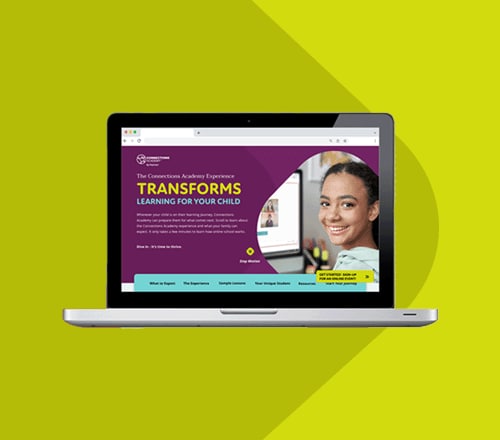Differences Between Real Time and Anytime Learning
byConnections Academy
5 min to read
Real time, anytime, or blended learning? And what about online school, virtual school, cyber school, remote learning, or distance learning? If you’re confused by these terms, you’ll appreciate today’s post, which explains the terms and how different instructional approaches are being used to create more student-centered learning experiences.
Different Instructional Approaches Explained
When technology began transforming how, when, and where students learned, educators began using the terms synchronous learning, or teacher-led and real time learning, and asynchronous learning, a type of learning that is anytime, anywhere. These were coined to distinguish between face-to-face classes and self-paced learning. But what do these phrases mean today?
What Is Real Time Learning?
Real time learning (synchronous instruction) means that students and teachers work together at the same time and in the same place. But with today’s technology, that “place” can be either a face-to-face, traditional school classroom or an online space that acts as a virtual classroom. Typical synchronous instruction involves teacher-led or –facilitated, in-class lessons or lectures, group projects, and class discussions.
What Is Anytime Learning?
In anytime learning (asynchronous instruction), students work at their own pace and in their own place, completing coursework within defined time limits. Students and instructors don’t necessarily interact in real time. Schoolwork that students perform on their own time typically includes:
- viewing prerecorded videos or class sessions at home
- reviewing course materials online or off-line
- completing assignments
- collaborating with other students via secure message boards
Combined Synchronous and Asynchronous Learning
Full-time, K–12 online schools, such as Connections Academy®, combine asynchronous learning from home and synchronous learning that occurs in an online classroom.
Other blended learning environments may combine in-person, synchronous instruction on a school campus with asynchronous, self-paced learning at a time and place chosen by students and parents.
What Is the Difference Between Online School,
Virtual School, and Cyber School?
While online school is by far the most commonly used term, virtual school and cyber school mean the same thing. These three terms can be used interchangeably. Online school is also sometimes called distance learning; although in 2020, that definition has been incorrectly broadened to include the emergency education scenarios that most schools were forced to adopt due to COVID-19.
What Does Distance Learning Mean?
Distance learning is a more general term, meaning that the student and the teacher are in different locations. The term doesn’t specify if learning is synchronous or asynchronous. This can also be called “remote learning.”
The Benefits of Synchronous and Asynchronous Learning
What’s significant about synchronous and asynchronous learning? These two different approaches can be used to enable students to learn in the way that works best for them.
Some students thrive with one-on-one attention, while others crave the space to work through problems independently, at their own pace. Combining or choosing effectively between the two learning approaches, K–12 online schools can now create a more personalized learning experience, geared to various learning preferences.
Synchronous Learning Benefits
Interactivity is the key to synchronous instruction, online or on campus. It allows:
- students to show their knowledge and practice their communication skills
- students to ask questions to deepen their understanding
- students to build relationships with their teacher and fellow classmates
- teachers to engage students in discussions, problem-solving, and group projects
- teachers to focus class time on bridging skill gaps
- teachers to build one-on-one relationships with students
Teachers can even record class discussions and lectures, making them available as asynchronous materials to reinforce learning or accommodate student scheduling conflicts.
Asynchronous Learning Benefits
Through asynchronous instruction and materials, we can provide students the flexibility to:
- continue learning without disruption during school closures
- learn at their own pace, place, and peak times, unconstrained by others’ schedules
- work at their own level, moving as quickly or slowly through course materials as needed
- study without the distractions found in a traditional school environment
- review difficult materials as often as needed
- explore resources that may be unavailable in the traditional classroom
Blending Synchronous and Asynchronous Learning
Whether in a blended or fully online school environment, today’s students increasingly need to move smoothly between synchronous and asynchronous learning. As they progress through grades K–12, they’ll also have to take increasing responsibility for those transitions.
If your student is moving between real time and anytime learning activities, here are a few tips to keep them on track in both environments:
- Take full advantage of your school’s orientation courses, resources, and activities designed to help students succeed online and off-line.
- Use your school’s online tools to monitor progress, communicate with teachers, and track school and outside activities.
- Schedule time realistically for your student’s schoolwork, and be mindful of deadlines and their personal work pace. Asynchronous means anytime when it’s convenient, not anytime that your student happens to get around to it.and his or her personal work pace. Asynchronous means anytime when it’s convenient, not anytime that your student happens to get around to it.
- Provide Learning Coach support for younger students when they’re “stuck,” and consult online school teachers for help.
- Encourage older students to reach out to teachers and school staff directly by email or phone when they need help.
- Read school emails. If your student’s teacher sent an email, there’s a reason.
- Don’t have students rush through online assessments if they don’t understand the lesson content. Have your child take advantage of the online learning environment to pause, reflect, or reach out to the teacher for help.
Understanding the advantages of both synchronous and asynchronous learning can help you make the most of your child’s education. You have the power to improve learning outcomes by choosing the approach that works best for your student. Learn more about how you can support learning at home with an accredited, K–12 online school.



